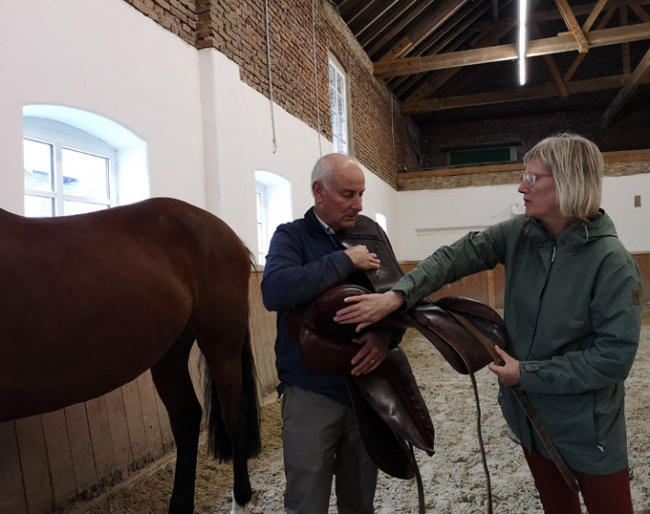
The Equine Orthopaedics Case Days were held in Germany, 21 - 24 September 2019 at the Burg Müggenhausen equine hospital and were organized by Arno Lindner (AG Pferd). The topic of the course this year was equine back problems related to orthopedics and the attendees were mostly veterinarians from different parts of the world.
Instructors Sue Dyson (United Kingdom), Ian Bidstrup (Australia) and Rikke Schultz (Denmark) went through their protocols of how to diagnose lameness with the back in focus. Back problems are difficult because they can be quite unspecific and secondary symptoms are pretty common.
The course's approach was practical, and the equine patients were dealing with different kind of problems in their performance and movement. The team of veterinarians evaluated the cases with routine, maintaining an individual approach for every horse, then sharing and completing the knowledge of each other. Good, clear routines are an important basis for any lameness examination. To make different problems visible, different surfaces and ways of testing are needed to create a good overall picture of the situation. Any pain in the body will create discomfort and an individual variety of compensations, but there are still clues and movement patterns that are typical in certain kind of problems.
Examinations
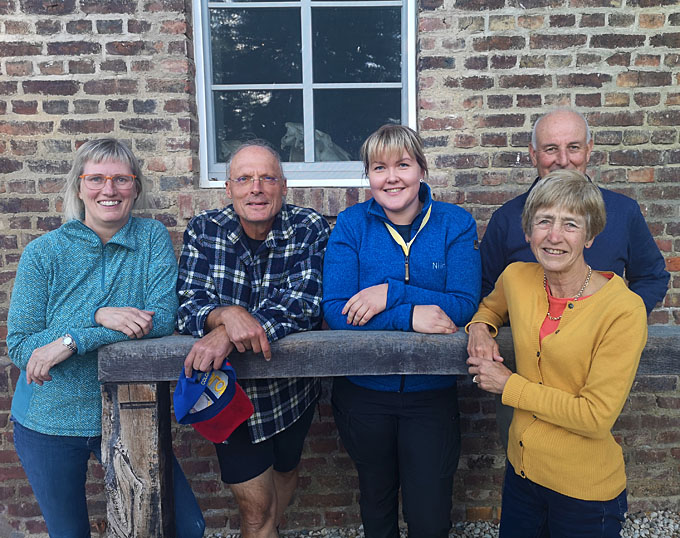
Ian Bidstrup, Sue Dyson
After the movement evaluation, flexion tests were done. Nerve blocks of the distal limb are also often used in lameness examination to locate the painful area. Blocking the nerve takes away the proprioceptive function of the lower limb below the point of the block, and it can cause the lameness to disappear or become more visible.
Sue Dyson: Look at the Whole Horse
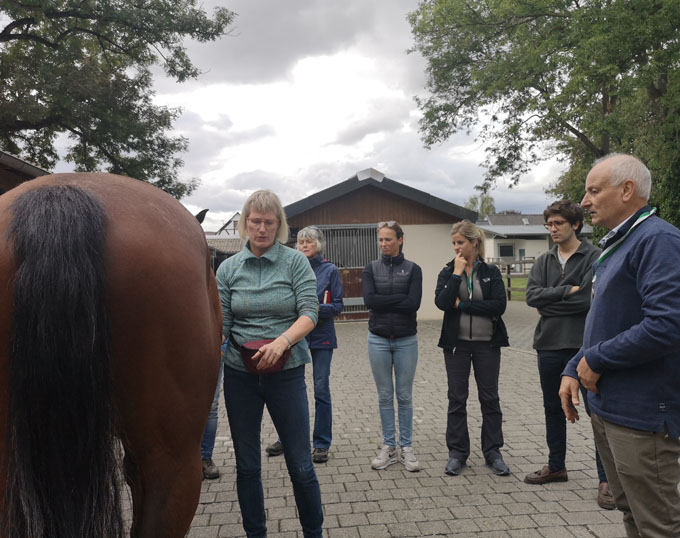
Dyson reminded the attendees that every horse that is not moving normally will show changes in musculature and end up with a reduced range of motion. Hooves and other parts of the body may appear asymmetrical, so it is best to take a good look at the whole horse. Gentle palpation, movement tests and professional lameness examination will help the vet to find clues of the problem areas. It is very important to remember that everything has an effect in the big picture. Checking the equipment and saddle fit, following the horses reactions while being tacked up, seeing the owner ride – all these are valuable details when searching the source of the problem. If the saddle is not fitting, it will be difficult to evaluate lameness and the effect of nerve blocks used in lameness examination. It is also good to notice that it is not normal that the horse seeks himself immediately behind the vertical while being ridden, also staying above the bit may be caused by pain or other reasons. There may be multiple reasons behind one problem. In the ridden examination Dyson used a 10m diameter circle to evaluate the situation. Rising trot on the right or wrong leg could also give clues about discomfort, often on lumbar area, and the difference was clearly visible with some horses. Dyson also talked about the ridden horse ethogram, which was developed to help recognize signs of discomfort in ridden horses. It is a scoring system for recognizing pain in ridden horses.
Rikke Schultz: Tension Behind the Behaviour
Rikke Schultz runs a private equine practice with complementary medicine since 2006. In 2010 she was enrolled in a Master study at the Anglo-European College of Chiropractic Care in Bournemouth University, England. Between 2011 and 2013 she was involved in a research project on “Myofascial chains in horses” at the Royal Danish Veterinary School and has been lecturing on non-pharmaceutical pain alleviation, acupuncture, manual therapy and myofascial release techniques in European and North America.
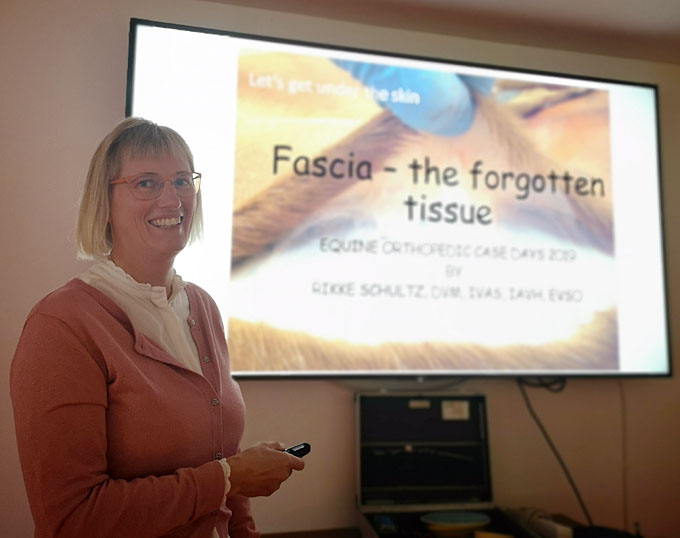
Some problems which riders experience in their seat can exist because of the horse’s way of moving. Of course the rider can be causing the problems too, but it is important to listen to what the rider is experiencing in the saddle, because this may help to understand what is happening in the horse’s body. The saddle can glide forward when the horse is stiff in the back. There are many other things that can happen too, but let´s try to keep it short. The horse may be carrying the tail on one side, or the saddle can slip to one side or both sides causing pressure on the spine and soft tissues around it. Horses carry the tail more often to the left, but this doesn’t automatically correlate with the lame side, even if crooked tails are more often seen on lame horses. Tail musculature goes all the way to the last lumbar vertebrae, so the tail is an important clue while searching for asymmetries and different compensatory patterns. Lumbar area soreness can be a reflection of somewhere else, for example stiffness or soreness in thoracic or cervical areas can change the function of the horses hindquarters – or the other way around.
Ian Bidstrup: Traumas at Birth
Ian Bidstrup has devoted the last 25 years of his veterinary career to treating spinal pain and spinal dysfunction of horses. His additional qualifications include a Masters Degree in Chiropractic Science and a Certification in Veterinary Acupuncture (IVAS). Ian’s particular interests include birth trauma associated asymmetry, girth pain, kissing spines, stifle lock, sacro-iliac dysfunction and saddle related spinal pain.
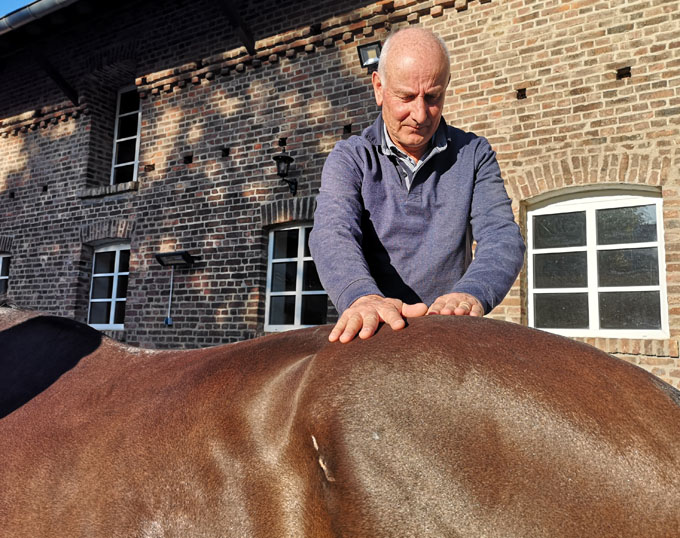
Conclusion
All instructors were highlighting the importance of taking care of the whole picture while recognizing the specific underlying reasons behind each horse’s problems. Discussions with owners, management and good, variable sustainable training methods are the keys to success.
Problems in the back may sometimes be pathological, but also functional problems are common. Once they are addressed, the horse may hopefully continue his career or life in the best possible way and the owners have a change to learn important skills to train their horses the best they can.
Text by Niina Kirjorinne and Silke Rottermann
Related Links
Effect of Noseband Positioning to Fascial and Neural Dynamics of the Head
Functionality in Equitation: Fascia Treament - Surface Has a Deep Effect
Functionality in Equitation: Fascia and Movement